December 5, 2019 | Vol. 6 No. 26 (This column published in print in the Minnesota Spokesman-Recorder on 12/5/2019)
“Easy” is not a word easily spoken among the poor: Things are hard – the times are hard, the way is hard. “Easy” is for uniformed explanations issued by the willfully callous and the haughtily blind.
—Charles M. Blow
The quote above comes in response to a 2015 Pew Research Center report that showed a majority of wealthy Americans believe the poor have it easy due to the government assistance they receive. To further his point, Charles M. Blow, award-winning op-ed columnist for The New York Times, also summons the spirit and wisdom of the legendary James Baldwin.
In the essay, “Fifth Avenue, Uptown”—which depicts everyday life in Civil Rights era Harlem, a full four years prior to the riot that engulfed New York City’s “Black mecca” in July of 1964—Baldwin famously wrote that “Anyone who has ever struggled with poverty knows how extremely expensive it is to be poor.”
Those living in poverty generally pay more in state and local taxes, contribute a much higher percentage of their annual income toward housing and transportation costs, and often find it difficult to access affordable, high-quality foods.
In fact, a story from last week’s Star Tribune underscored the trials and tribulations of grocery shopping among residents of Minneapolis’ Elliot Park neighborhood, where three-fifths of the population is considered low-income and nearly 40% live below the poverty threshold.
Plus, another new brief, this one from the Center on Poverty & Social Policy (CPSP) at Columbia University titled “The Cost of Being Poor,” advances the point. The CPSP study explains that in addition to the vast disparities in income growth in recent decades, “prices have risen more quickly for people at the bottom of the income distribution than for those at the top—a phenomenon dubbed “inflation inequality.”
The result, according to the CPSP, is that an additional 3.2 million Americans are essentially living in poverty even if they are not officially counted among the ranks of the poor. And, because they technically still remain above the federal poverty guidelines, these individuals and families who are in desperate need of food support, rental assistance, and additional anti-poverty initiatives, simply do not qualify.
For certain, I have used these pages from time to time to address the shameful and woefully inadequate way that poverty is measured in the United States. For example, in 2020, a four-person household bringing in $25,750 or less per year qualifies as poor.
But, as the National Low-Income Housing Coalition’s “Out of Reach” report reveals, an annual income of around $26,000 is already a good $15,000 short of what it would take to secure a (fair-market rent) two-bedroom apartment in the state of Minnesota. But I digress.
What this notion of inflation inequality really means is that, in addition to pulling another three-plus million people into poverty, the mounting gaps in wealth and income (as bad as they seem up until now) are even “notably larger than we thought.”
Moreover, as the Federal Reserve’s current inflation strategy already “significantly understates income inequality and poverty,” newer proposals to lower the poverty line would —if successful—leave millions and millions of more low-income citizens without access to critical government benefits and income supports.
Christopher Wimer, Sophie Collyer, and Xavier Jaravel—authors of the CPSP report—stringently advise against such a policy prescription as they declare:
“Taking seriously the actual inflation rates faced by those at the bottom of the income distribution indicates that we currently have a too-rosy view of the actual levels of deprivation faced by those at the bottom of the income distribution. We should be doing more, not less, to help them makes ends meet.”
I’m not sure that there are too many among us, especially those living low-income realities, who have a “too-rosy” view of income distribution in this country. We are well-aware that things are really bad and thanks to this particular study, we now know that they are, indeed, even worse (as implausible as that might seem).
What I most certainly do agree with, is that we should be doing more. So, as did Charles M. Blow, let us lift up the words of James Baldwin, who once proclaimed that “Those who say it can’t be done are usually interrupted by others doing it.”
So, let’s do this.









